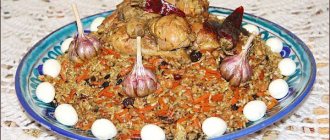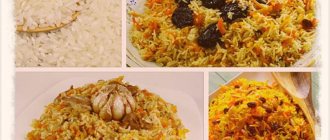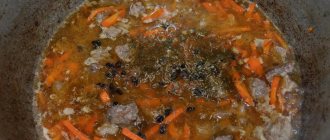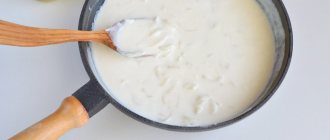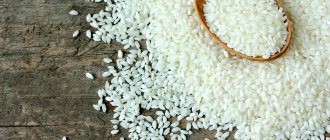Recipe 1: Homemade beef pilaf
This recipe is quite simple, so it is accessible even to novice cooks. It’s hard to resist its aromas, because pilaf is truly a royal dish.
Ingredients
500 g beef; third stack. vegetable oil; 50 g lard; 500 g carrots; 500 g onions; 1 stack rice; 6 cloves of garlic; spices - barberry, cumin, hops-suneli; salt.
Cooking method
First you need to prepare zirvak - the base of pilaf, consisting of meat, onions and carrots. Heat a cauldron and pour oil into it. First we put the onion there, bring it to a golden color, then the meat and a piece of lard (before adding rice, it must be removed). After about 7 minutes - carrots. Zirvak takes about 20-30 minutes to prepare. over medium heat. Half the time it is fried without a lid, stirring constantly, and then the cauldron is closed, stirring only occasionally. In the middle of this whole process, the zirvak must be salted and spices added.
Gently pour the washed rice on top of the zirvak without stirring. Fill with cold water just to cover it. Cover the cauldron with a lid and cook until tender at a low boil. In 10 min. Before the end of cooking, stick garlic cloves into the pilaf.
In order for the taste to be even more intense, you need to wrap the pilaf in a blanket and let it stand for half an hour to an hour.
Recipe 2: Uzbek beef pilaf
Who cooks pilaf better than the Uzbeks? After all, this is their national dish. Therefore, if you adhere to some mandatory rules, you will certainly get a delicious dish prepared in the best Eastern traditions.
Ingredients
beef meat - 1 kg; onions - 700 g; rice - 1 kg; carrots - 700 g; barberry, cumin and thyme - 1 teaspoon each. false; garlic - 1 head; ground black pepper and salt - at your discretion; vegetable oil - 4 tbsp. lie
Cooking method
If there is a lot of fat on the meat, then it is advisable to cut it off, leaving just a little bit. Heat a cauldron and pour oil into it. Fry the meat so that it is browned on top and remains juicy inside. If there is not enough oil, you can add it. Remove the beef from the cauldron and fry the onion in the same oil, then return the meat and add the carrots. Fry the zirvak with the lid open until the carrots have reduced in size by 3 times.
Now you need to salt the zirvak and pour rice into it, pour boiling water 1 finger above the level of the food, mix everything well and taste for salt. If necessary, add salt to taste. Simmer with the lid closed until the rice is cooked. About 10 minutes before the end of cooking, stick a head of garlic into the pilaf. Add water to the holes as needed so as not to damage the integrity of the grain at the end of cooking. After turning off the heat, you need to let the pilaf brew for another 20 minutes, and then stir it and you can serve it.
How to cook pilaf so that the rice is crumbly
In order for you to get a real crumbly pilaf, there are a few simple recommendations. This has already been written about in previous recipes. But I also want to invite you to clearly see that your actions are correct. That’s why I’ve put together a detailed video recipe for you.
Ingredients:
- Pork – 500 gr
- Long grain rice – 500 g
- Carrots – 500 gr
- Onion – 500 gr
- Garlic - 1 head
- Seasoning for pilaf - 1 tablespoon
- Salt - to taste
- Vegetable oil - 100 ml.
Our review is over for today. If you want to get truly delicious pilaf, then just do everything according to the recipes described. And then you will have a flavorful dish for lunch or dinner that everyone in your household will enjoy. Choose any convenient method and cook for your health.
Bon appetit! Bye!
Recipe 3: Fergana pilaf
This is a classic of the genre. Of course, in different parts of Asia, pilaf has its own taste characteristics, but Fergana pilaf is the limit of perfection. There are no clear canons in its preparation, since pilaf forgives improvisation, but not in the main components.
Ingredients
beef meat - 300 g; onion - 250 g; rice - 500 g; carrots - 250 g; vegetable oil - 250 ml; spicy mixture - 1.5 teaspoons. false; salt - to your taste.
Cooking method
Pre-soak the washed rice for 30-40 minutes. Heat the oil in a cast iron, add the onion and fry it for 5-7 minutes. Next, add pieces of beef to the onion and fry everything together for another 15 minutes. Add raw carrot strips and extend the process for another 10 minutes. Add salt, pour in water (1/4-1/2 cup), bring to a boil and add spices (cumin, saffron, barberry, turmeric and red pepper). Simmer with the lid closed for about 2 hours.
Pour rice over the meat, level the surface, pour hot water so as not to disturb the top layer. Simmer until the cereal is ready, remembering to add water to the wells. After removing from the heat, leave the pilaf for another 15 minutes. and then served.
There is no need to be afraid to mix rice with zirvak while preparing pilaf, because in the classic version this dish is cooked in a cauldron over an open fire. Since we cannot adhere to such conditions, the cereal must be mixed so that it is well saturated with the taste of meat and spices.
Despite the fact that in classic pilaf recipes it is recommended to use lamb as a meat component, pilaf with beef, when prepared correctly, turns out no less tasty and aromatic. In our country, beef is one of the most popular varieties of meat. Due to its nutritional and taste properties, beef is used in the preparation of many dishes, including pilaf. It is no secret that not everyone likes the specific taste of lamb, and in such cases, beef becomes an almost ideal substitute that does not have a negative impact on the taste and aesthetic qualities of this dish. True, as in the case of other types of meat, much depends on the correct choice of product and adherence to the technology of its preparation.
When choosing meat, you should take into account that beef is very heterogeneous - depending on the age and breed of livestock, meat can have different properties. So, unlike extremely tender veal, the meat of adult animals can be very tough due to the presence of a significant amount of rough muscles and tendons. For pilaf, the optimal meat is meat from fairly mature, but young, well-fed animals, whose age does not exceed two years. As a rule, such meat has a rich red color. You can also use veal for pilaf, but it should be taken into account that its qualities are very different from beef and require special cooking technology. Some people prefer veal due to misconceptions about the toughness of beef. In fact, the taste of properly prepared beef is in many ways superior to veal.
The preferred parts of the animal carcass for pilaf are shoulder, brisket, knuckle or shank. Some recipes indicate that the meat of the hind leg is also suitable for stewing, but in fact this part of the carcass, like the back of beef, is full of muscles. To obtain an acceptable result, the meat has to be stewed for a long time, and, nevertheless, it remains quite tough and fibrous. When preparing beef pilaf, keep in mind that the meat must be stewed for at least three hours. Therefore, zirvak must be cooked longer than usual, adding carrots to it later. If the meat is covered with a layer of fat, it is recommended to cut it off, leaving only a small part of it.
In no case will we claim the title of classic pilaf with pork, since dishes with this meat will never be prepared in our homeland. So our version is purely Russian, but so that we don’t end up with porridge with meat, we’ll take some rules and principles for preparing real pilaf and transfer them to our dish. There will be two recipes: the first is extremely simple, in a frying pan, for a quick dinner, without much dancing with tambourines; the second will be more like its older brother, it will be cooked in a cauldron with more careful adherence to the basics. Both will be step by step and with photos.
Basic principles of cooking pilaf that we will need
However, first, let’s talk about the products and these very basics. It is clear that pilaf is a dish of meat with rice. Today we have pork.
Which part of the pork carcass (cut) is best to use for pilaf?
It is believed that for stewing (and in my opinion, pilaf is frying followed by stewing), a shoulder blade and ham are best suited. But of these, the ham is more expensive, the shoulder is much cheaper, and in its finished form it is not inferior to it in taste.
How to choose rice for pilaf?
You need long grain rice. As a rule, it does not boil down into mush or stick together. Very often it is recommended to soak cereals for a short time in hot water. It is believed that this way it will turn out more crumbly. Based on this, you can successfully buy steamed rice and get good results without soaking.
What is zirvak?
This is a part of pilaf without grain. Those. ingredients such as meat, carrots, onions and everything else that is cooked in the first stage before the rice is put in.
What kind of cookware is suitable for cooking pilaf?
In everyday life at home, it is best to take thick-walled dishes: frying pans with a thick bottom, ceramic fireproof pans for stewing, duck pots, etc. The fact that it takes a long time to warm up well, but once heated, keeps the heat well.
What spices are needed?
Ready-made sets of spices for pilaf are available for sale. They usually contain: cumin, barberry, hot pepper, turmeric (or saffron), dried onions and garlic. It is best to look for seasonings in the market by weight; they will be fresher and more aromatic than those packaged in factory packaging.
What seasonings are added to pilaf
To prepare good pilaf, it is not enough to know what is included in the seasoning. It is important to maintain the correct proportions of adding the mixture to the dish. The calculation is made depending on the amount of meat. So, if pilaf is prepared from 1 kg of meat, then 1/3 tablespoon of the mixture will be enough to give a weak taste. 2/3 of a spoon will make the taste more pronounced, and a whole tablespoon will give the pilaf a strong richness.
What you definitely shouldn’t do is pour spices into boiling fat. Instead of a magical taste, you can get an unpleasant bitterness. It is better to add spices to the cauldron when the meat is well fried and there is less fat.
Oriental dishes differ in taste due to a certain set of spices. The main component is cumin or cumin. Seasonings are sold in grains or ground form. They are used as independent seasonings for dishes or as part of spice mixtures. Zira and cumin are added to real meat and fish pilaf.
Black cumin (Indian) is a hard-to-find seasoning, the grains of which can sometimes be replaced with carrot seeds. To determine the authenticity of the spice, when purchasing, rub several grains with your fingers - cumin has a distinctive smell. Barberry berries have a sour taste, neutralize excess fat on meat and promote better digestion of such a fatty dish.
Berries must be included in the preparation of real pilaf. Garlic is used in appetizers, sauces, pickles and main dishes. The plant adds a strong, pleasant smell and taste to pilaf. Saffron (replace with the more accessible turmeric) – adds a golden hue and subtle aroma to the dish. Used in proportions 05, tsp. spices for 1 kg of rice.
The classic composition also includes dried ground tomatoes, paprika, hot peppers, and coriander grains. Suitable dried fruits for oriental dishes include: dried apricots, prunes, dried small grapes. Less commonly used spices:
- cinnamon;
- sumak - a spicy spice with a sour taste, burgundy tint;
- savory - a bitter, hot spice, similar to pepper;
- nutmeg;
- sprigs of rosemary - have a characteristic pine smell, in small quantities they are pleasant to the taste;
- natural vanilla;
- savory - a bitter, spicy seasoning similar to pepper;
- fenugreek - found in the hop-suneli mixture, has a nut-mushroom aroma and a bitter taste.
"Attention!" All dried herbs are added in the middle of the pilaf preparation process, after frying vegetables and meat. So that each ingredient of the dish absorbs all the characteristic properties of herbs.
For such pilaf, not many seasonings are used, but they still add excellent taste to the dish and are good for health. The dish receives many vitamins (PP, H, B, E) and minerals (iron, magnesium, zinc, potassium, calcium, selenium, ß-carotene).
Set of herbs for pilaf with chicken:
- dried, chopped chili and red paprika;
- cumin seeds;
- fresh/dried parsley;
- black pepper;
- barberry berries;
- thyme;
- dried/fresh garlic;
- saffron (turmeric).
Do not overdo it with the amount of seasonings; add each one separately at different stages of cooking. Dry, ground herbs are added to zirvak - this is the stage of cooking pilaf, when vegetables and meat are cooked in a cauldron, but the cereal part has not yet been added. The final taste of the dish depends on the correct preparation of zirvak and the mixture of seasonings. Add the prepared seasoning mixture 20 minutes before the end of cooking.
Interesting! The most popular pilaf is Uzbek style pilaf. Legend has it that the dish was invented during the time of Tamerlane. The conqueror gave orders to his cooks to prepare a quick dish that could satisfy a whole horde. The same ones came up with pilaf, which satisfied the wishes of their owner.
The dish is called pilaf precisely because it includes a mixture of certain oriental seasonings. Without this mixture, you can only get rice porridge. The quantity and type of seasonings should be chosen by everyone independently.
Buy all seasonings whole and grind them yourself in a mortar or coffee grinder to extract as much flavor and smell as possible. Store the seasoning in a tightly closed container.
It is not recommended to exclude the main components of the mixture, but some of them can be replaced: cumin with cumin, saffron with turmeric, barberry with raisins/cranberries. Use only fresh garlic; dried garlic will give an unsuitable flavor for the dish.
When the zirvak is almost ready, before pouring water and adding rice, add the following seasonings to the zirvak: sumac, cumin or cumin, lava leaf, rosemary, basil, turmeric, ground paprika. It’s up to you to decide for yourself about adding barberry, pomegranate seeds, cardamom – it’s a matter of taste and experience. When the rice is half-cooked, do not forget to add a whole head of garlic, in its peel.
To prepare real pilaf yourself, you first need to prepare certain seasonings. The following ingredients are required in the seasoning mixture:
- barberry – 4 tsp;
- zira – 2 tsp;
- coriander seeds – 0.5 tsp;
- dried tomatoes – 4 pcs.;
- black pepper – 0.5 tsp;
- a little saffron;
- dried red, green hot pepper – 4/4 pcs.;
- Goal. garlic – 1 pc.;
- thyme (optional) – 1 tsp.
Measure and pour cumin, coriander, saffron into a container, then grind the tomatoes and pepper and add to the rest of the ingredients. Store the mixture in an airtight container and use as needed.
From lamb
- Thyme. This is dried thyme; it adds a special piquancy to meat foods, including pilaf with lamb. The spice combines ideally with garlic and fresh herbs.
- Cumin (jeera). The spice is widely used in Mexican and Caucasian cuisines. It has a sharp, bitter-spicy taste with a barely noticeable nutty aroma. The smell of cumin is sweetish, a little reminiscent of caraway seeds. Cumin is considered an ideal seasoning for rice and lamb.
- Chile. Peppers are sold chopped and dried. It gives the pilaf a pronounced spiciness and stimulates the digestion process.
- Barberry. The spice is dried fruits of black or red color (depending on the variety). The barberry seasoning has a tart, sour taste, which complements the range of taste qualities of pilaf, making them more contrasting.
Oriental seasonings
Spices such as barberry, cumin, and ground saffron give pilaf a special oriental aroma and taste. It is better to buy them in the market by weight. To distinguish cumin from spice-like carrot seeds, crush the grains with your fingers - the real spice is not difficult to distinguish by smell. Cooks recommend buying dried black barberries for rice, but if this is not available, red berries will also work. They will give the food a pleasant sourness.
Purchasing saffron is the most problematic matter, since the natural spice has a very high cost. What is sold on the market at a cost of 20-40 rubles per spoon is nothing more than turmeric. In terms of its properties, the spice is not much different from saffron: it has an islandy taste and a delicate aroma of pepper and citrus.
Uzbeks do not use dried fruits when preparing rice with lamb - they are placed exclusively in a vegetarian dish. Other eastern nationalities prefer to flavor their pilaf with dried apricots, figs, raisins, and prunes. If you like to combine meat dishes with dried fruits, choose fruits that are not very brightly colored to avoid chemically treated products. Dried apricots and prunes should be wrinkled, have a slight coating and uneven color.
Review of seasoning for rice (pilaf). | Overview seasoning for rice
Found an error in the text? Select it, press Ctrl Enter and we will fix everything!
Pilaf with pork in a frying pan - recipe with photo
Ingredients:
- pork shoulder – 400g;
- rice – 350g;
- carrots – 1 piece;
- onion – 1 piece;
- salt - to taste;
- tomato paste – 1 tsp;
- spices for pilaf;
- vegetable oil – 0.5 cups.
How to cook pilaf with pork
- First, let's prepare the products. Cut the meat into medium-sized pieces.
- Carrots are usually cut into strips, but for simplicity and speed, we grate them on a coarse grater. There should be a lot of carrots. Finely chop the onion.
- Pour vegetable oil into the frying pan. Despite the fact that pork is fatty meat, you will need a fair amount of oil. The rice will then absorb it well, become oily, and the pilaf will not be greasy. Warm it up well.
- Add the meat and stir until all the pieces are coated with oil. Fry for 10-15 minutes until a crust forms, stirring occasionally.
- Add carrots and onions. Mix everything well. Cook for about 5 minutes so that the vegetables also fry a little.
- Add spices. Their number depends on your preferences. Some people like the aroma to be very subtle, others like it to be pronounced. The quantity also depends on the quality; you will need less fresh spices. So take a look for yourself. I usually put about 1 teaspoon.
- Salt and add tomato paste.
- Pour the rice into a cup in advance, so that you can then pour water into it. Spread the rice on top of the zirvak in an even layer.
- And fill it with hot water from the kettle (boil it a little in advance). The amount of water is determined by the volume of rice. Let’s say you had 1 glass of rice, which means there should be 2.5 times more water, i.e. 2.5 glasses.
- Cover the pan tightly with a lid. Reduce the heat to the lowest possible level and leave to cook until all the water is absorbed and the rice is soft.
- When we see that there is no more water on the rice, we taste it. If it is soft, the pilaf is ready. But pay attention, the top layer of rice can be, as the Italians say about pasta, “al dente”, i.e. slightly hard, while inside it will be completely soft. If you notice that there is still liquid left in the pan, close the lid and wait a little longer.
- Usually pilaf is not stirred, but I like to do it this way: when it is ready, I turn on high heat and, heating it strongly, stir the contents of the pan for 1 minute.
That's it now! The dish is ready, you can call everyone to the table.
Traditional composition
In Central Asia, spices are the essence of national dishes. For 1 kg of meat, ⅓ tablespoon of a mixture of spices will give a light flavor, ⅔ tablespoon will give a medium richness, and a heaping tablespoon will make the pilaf rich.
Over time, a traditional set of spices developed for pilaf:
- Zira (cumin) - 1 teaspoon. Grains are used. The main spice for pilaf. Both whole grains and ground into powder are taken. Can be replaced with cumin.
- Barberry - 15 grams. Pilaf is a fatty dish, and it’s good to feel a sour note in it, which is what barberry does. Can be replaced with dogwood.
- Saffron - a pinch. This spice gives the dish a golden hue and a pleasant aroma. Sometimes replaced with turmeric (1.5 teaspoons).
Garlic is definitely included, it needs to be mentioned, although it is not a seasoning. This spicy plant is popular in oriental cuisine. It has a strong aroma, which creates an appetizing taste and smell of the dish.
- Vanilla.
- Cinnamon.
- Nutmeg (ground).
- Sumac - the seasoning gives a sourish-astringent taste to the dish, but does not give off any smell.
- Rosemary - adds a pine-like aroma and a slight pungency.
- Savory - tastes like hot pepper.
- Fenugreek is a very strong spice; to some, the taste of fenugreek is reminiscent of nutty or mushroom.
Recipe for pilaf with pork in a cauldron
The cauldron should ideally be cast iron, but it is now very difficult to find one. Mostly aluminum ones on sale with or without non-stick coating. It is good to cook pilaf in such a container on the stove or over the grill (with a special grill for the cauldron).
Product composition:
- pork ribs – 1.5 kg;
- long grain rice – 0.5 kg;
- onions – 5 pcs;
- carrots – 3 pcs;
- spices;
- ground black pepper;
- salt;
- garlic – 1 head;
- chili pepper – 1 pc.
How to cook pilaf with pork
- Wash the ribs and cut them into separate pieces with the bone. If they are long, cut them in half. If there is lard, do not trim it.
- Peel the onion and cut into half rings.
- Cut the washed and peeled carrots into thin strips.
- We will cook without oil. Therefore, first we put two pieces of pork into a heated cauldron and wait for the fat to render out. Then we rotate them there to lubricate the walls of the cauldron with the rendered fat and add a few more ribs.
- Fry them on all sides.
- Add the onion and fry until transparent.
- Now you can add all the remaining meat.
- Add spices.
- Add carrots and fry the whole zirvak well.
- Fill with hot water so that the rut covers all the pork and vegetables. Add a whole, unpeeled head of garlic and chili pepper. Cover with a lid and cook for 1.5 hours.
- After this time, remove the garlic and pepper. Don’t throw away the garlic, it’s very tasty and you can eat it later with pilaf.
- Rinse the rice several times with running water until the water becomes clear. We put it in a cauldron with a slotted spoon, level it, but under no circumstances mix it with meat. If necessary, add a little water to cover the rice. Close the lid again and cook for 20 minutes.
- During this time, the rice will cook until half cooked. Use a slotted spoon to scoop it towards the center to form a mound. You can return the pepper and garlic to the cauldron. Stop heating, cover the lid and let the pilaf sit for about half an hour until the rice has absorbed all the water and becomes soft.
That's all! Your pilaf in the cauldron is ready!
Pilaf is a dish that everyone loves without exception. Juicy, satisfying, aromatic. It looks great on the holiday table, and is prepared quite quickly and easily. But there are many subtleties, without knowing which you won’t be able to cook truly delicious pilaf. Many housewives are faced with the fact that instead of being crumbly, it turns out sticky. Yes, rice porridge with meat is also good, but not at all what I would like. Therefore, the choice of ingredients must be taken very seriously. Today we’ll talk about which meat is best for pilaf.
Seasoning for pilaf: composition of spices for Uzbek cuisine
A classic Asian recipe for a spice mixture for pilaf should look like this:
- Zira (or cumin) – 1 tsp. Jeera grains are used both whole and ground. In some recipes, cumin can be replaced with regular cumin.
- Barberry – 15 g. These berries are added in their entirety. Barberry gives the dish a special sourness and helps digest fatty meat. It is not always possible to find pure barberry on sale, then it is replaced with dogwood.
- Saffron – 1 pinch. The spice makes the pilaf golden in color and pleasant to smell. True, real saffron is expensive and difficult to find. Therefore, turmeric, which is similar in color, is most often used. You need to put more of it - about 1.5 teaspoons.
These three spices form the essential base of spices for pilaf. Then onions and garlic are added to them, giving an appetizing smell and spicy taste to the dish, as well as other spices.
Traditional composition
Seasoning for pilaf is exactly what gives the dish a unique, incomparable strong, attractive aroma. It is the bouquet of seasonings for pilaf that creates the unique taste of a hearty dish, popular not only in the East, but throughout the world.
We will tell you how to choose spices for pilaf in such a way as to achieve the desired effect - we guarantee that your dish will amaze you with its amazing taste and richness. In this review, we will look at several types of meat that are the most popular in cooking and are most often used by housewives and cooks around the world.
The peculiarity of oriental dishes is the abundance of seasonings. But it’s not enough to throw a few seasonings for pilaf into a cauldron; you need to be able to combine them correctly
The classic composition of the spice seasoning is as follows:
- Seasoning for pilaf cumin (also known as cumin). It is this component that is the main one and gives a unique smell and taste;
- Barberry is used to neutralize fat and adds sourness;
- Garlic enhances the taste and gives an appetizing aroma;
- Saffron (you can take turmeric) is the same yellow seasoning for pilaf that turns rice golden. As you understand, saffron and turmeric are not the same thing; many people sometimes confuse these seasonings.
In addition to the classic composition, the following seasonings are used:
- Paprika;
- Coriander;
- Red and black pepper.
No less important is the question of when to add spices to pilaf. Experts recommend adding ground seasoning before the rice boils. Let's move on to recipes for dishes with different types of meat and discuss each of them in detail.
With Chiken
Spices for pilaf with chicken highlight the tenderness of the meat and add piquancy - the bird has a delicate taste and texture that easily absorbs the characteristics of the pilaf seasonings.
What seasonings are added to chicken pilaf to achieve the desired result? Study the list:
- A teaspoon of cumin;
- ¼ teaspoon saffron;
- 2 tsp barberry;
- A few black peppercorns;
- Half a teaspoon of thyme;
- 1/3 tsp. chili pepper;
- Five cloves of garlic;
- Bunch of parsley
If you do not find the necessary seasonings for pilaf, you can replace:
- Saffron - turmeric;
- Zira – cumin;
- Barberry berries - dried cranberries or raisins.
Now you know what seasonings are needed for pilaf - let’s look at the step-by-step recipe:
- Cut the chicken (a kilo) into small pieces;
- Peel the garlic, grate two carrots on a coarse grater;
- Cut the onion into half rings and chop into quarters;
- Heat oil in a cauldron;
- Add chicken, onion and garlic;
- Wait until the bird turns white - add carrots;
- Add spices and stir. Add rinsed rice;
- Add enough water to cover the rice, cover with a lid and place on low heat without stirring;
- Cook for about 40 minutes until the water boils.
We also recommend: How to eat chia seeds
Do you want to cook a diet dish? Then take on the idea of using turkey! The recipe will be similar to chicken, but you can add a little curry and ground black pepper to taste. By the way, you can use other dishes for cooking - a saucepan, a saucepan or a slow cooker.
If you don't like chicken, you'll probably like a dish with fattier meat - and we'll tell you what spices you might need for pilaf with pork.
You will need spices for Uzbek-style pilaf, which were already discussed above - the classic set includes:
- A tablespoon of cumin;
- A teaspoon of barberry;
- 0.5 tsp saffron
Now that we have figured out what seasoning is needed for Uzbek pilaf, it’s time to start cooking. All proportions are given per kilogram of lamb and kilogram of rice:
- Pre-rinse (ten times) and soak devzira or chunggar rice in hot water;
- Pour oil into the cauldron and heat it until smoke appears on maximum heat;
- Add fat tail fat (200 g) and melt it, then reduce the heat;
- Add the lamb cut into large pieces and fry, stirring, until golden brown;
- Chop three onions into small cubes and place in a container, wait until they turn brown;
- Add carrots cut into long, large strips (two pieces) and cook until they soften;
- Salt, add spices and add four peeled heads of garlic;
- Add the cereal, spread it in an even layer and add salt, pour in water so that it covers the layers by two fingers;
- Bring to a boil, reduce the flame and wait until the liquid boils away;
- Set the heat to low, cover with a lid and keep for 45 minutes.
We also recommend: Herbes de Provence
Our latest recipe contains information about what seasonings are put into beef pilaf.
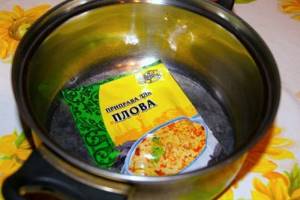
The composition of the seasoning for pilaf changes for each housewife - you can add or remove ingredients at your discretion. We offer you an easy way to prepare seasoning for pilaf at home - but we do not recommend storing them for a long time.
- Thinly slice the head of garlic;
- Add one teaspoon each of turmeric, paprika, barberry and cumin;
- Add a tablespoon of suneli hops and a pinch of dried herbs;
- Mix well.
Finally, we note that you can buy ready-made seasoning for pilaf at the market or in a store - they sell both ready-made mixtures and all the herbs separately.
Study the review, get inspired and start culinary experiments - we promise you that soon you will be able to enjoy the unique taste, aroma and oriental flavor!
Classic pilaf cannot be imagined without a lot of spices. They are the ones who create that unique, strong, appetizing smell that instantly makes your mouth water.
Spices for pilaf can be purchased at the supermarket - on the shelves with spices there are both ready-made sets for this oriental dish, and individual components from which you can create your own combination.
- ground black pepper;
- hot chili pieces;
- dried, or better yet, fresh parsley;
- cumin seeds;
- red and black barberry;
- dried red pepper;
- ground thyme;
- fresh or dried garlic;
- saffron or turmeric.
Chicken pilaf, as a rule, is not made too rich in spices.
Pork pilaf is famous for its juiciness, fat content and rich taste.
- sumac;
- rosemary;
- sweet ground paprika;
- dried basil;
- turmeric;
- garlic in any form;
- laurel;
- barberry;
- cumin.
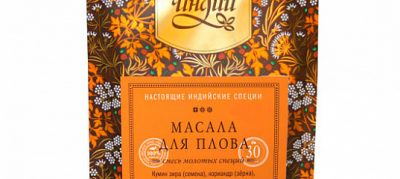
Everything except barberry berries should be crushed.
Turkey
For turkey pilaf, you can use the same set of spices that is suitable for chicken meat.
- turmeric;
- saffron petals;
- nut herb or curry.
If desired, you can add garlic and classic ground black pepper.
Traditional pilaf should have a rich and even spicy taste.
- hot pepper pods are the main source of spice for oriental pilaf;
- cumin/cumin - gives a strong aroma for which classic pilaf is famous;
- barberry - necessary for light sourness and strong aroma.
These three spices in the east are considered the main ones in the preparation of pilaf. Other spices are added in smaller quantities than the main three.
Preparing a mixture of spices is quite simple - you just need to mix the ingredients together and add them in the desired quantity during cooking. The amount depends on the person’s preferences - if you like rich dishes, you can add a little more, if more moderate ones, you can add less.
For example, for 1 kg of meat, ⅓ tablespoon of spices will create a light aroma, ⅔ tablespoon will give the dish medium richness, and a heaping tablespoon or more will make the dish rich, as eastern nationalities like.
The ingredients can be purchased in bulk at a spice store or in a grocery supermarket, packaged in small bags.
- For better aroma and taste, it is recommended to grind dry grains and herbs in a coffee grinder or grind them in a mortar. It is better to cut berries and fresh herbs a little and add them to the dish almost whole.
- If necessary or personal desire, you can replace some components. Saffron and turmeric, cumin and cumin, barberry and raisins/cranberries are considered interchangeable spices.
- Fresh garlic is more spicy, so it is preferable not to replace it with dried garlic.
- ½ tsp. l. turmeric/saffron;
- 1 tsp. l. sweet paprika;
- 5-8 barberries;
- 4-5 medium garlic cloves;
- ½ tsp. l. pepper mixtures;
- ⅙ tea l. cumin;
- 1 table. l. without a mountain of salt.
In ancient times, spices were used rather to preserve dishes due to the lack of a cool place to store food. And today, spicy richness has become integral to all oriental cooking.
21 Apr 2020 Tell VKontakte Odnoklassniki
This oriental dish is one of the most famous in the world. In each country, rice with meat is prepared differently, using its own set of ingredients and unique techniques. The only thing that remains unchanged is the mixture of seasonings for pilaf. They give rice that special taste and aroma that distinguishes the dish from many others.
Seasonings for pilaf
Spices not only add spiciness and pungency to Uzbek dishes, they also act as preservatives. Seasoning for pilaf in hot countries is necessary for longer preservation of the product. What spices are added to pilaf? This:
- saffron;
- cumin;
- cumin;
- barberry;
- paprika;
- garlic;
- onion.
Almost all pilaf recipes involve the use of pepper (black and/or red), in addition to the main spices. Hot varieties give food a spicy kick. Moreover, pepper is used both fresh and dried. If desired, today it is possible to purchase ready-made mixtures of seasonings for pilaf, in which all the necessary components are combined in the correct proportions.
From lamb
Your choice
Pilaf is very demanding when it comes to rice and spices. Don't try to cook a delicious dish if you only have short-grain rice for porridge. It cooks well and makes a delicious milk porridge. But in this case you need to keep the grains of rice intact. So try to choose long grain, And don't forget about the meat! Which one is better for pilaf?
In this regard, the dish is quite democratic. Almost any meat you have in your refrigerator will work for this purpose. Sometimes even... fish is used. But we should not forget that the taste of the finished dish will depend on the choice. Avoid meat from young animals. It quickly disintegrates into fibers and loses its taste.
Zira – the queen of spices in oriental cuisine
In India, cumin is used to season vegetable dishes. In Tajikistan and Uzbekistan, they like to add this spice to pilaf, soups, cold appetizers and baked goods. Ground cumin seeds are added to the famous Chili sauce.
Jeera seeds are a must in a popular Indian spicy mixture called garam masala, which has many different variations.
In Kyrgyzstan, cumin is used to marinate meat dishes, prepare fried meat with vegetables, and to add flavor to sauces. In other words, in the East almost none of the dishes, with the exception of dessert, are complete without cumin. In European cuisine, the Greeks add this spice to Smyrna-style sausages and stifato (stew). And the Bulgarians, calling cumin kimion, use it to prepare aromatic meat dishes.
Mutton
Traditionally, the meat of these animals is used to prepare delicious pilaf. However, not everyone likes the specific smell. If you belong to this category of people, it is better not to experiment, but immediately replace it. It will turn out no less tasty, however, the result will be slightly different.
In general, the question of which meat is best for pilaf is ambiguous. It depends on what end result you want. But if you want to cook exactly that classic pilaf from Central Asia, then you should give preference to lamb. It is sold in almost every city, although the choice may be worse than in the case of the same beef or pork.
Which piece do you like?
You can, of course, ask the sellers at the market. But they have a slightly different task - to sell all the meat available. Therefore, you may not get what you need at all.
So, on the agenda is lamb pilaf. What kind of meat is better to take? Discard the back leg - there are a lot of tough muscles here. It is best to take the ribs, shoulder blade or neck. You will get a good taste if you add a few ribs and fat tail fat to the pilaf.
According to traditional recipes, the meat is cut into large pieces, about 150 g each. First, the pieces are fried until brown. After this, add water to the cauldron and simmer them until soft. And only then can you fry the onions and carrots and add rice. It is recommended to fry meat at an oil temperature of 180 degrees. If the temperature is higher, it will char on the top and remain raw inside.
How to replace Khmeli-Suneli?
The composition of khmeli-suneli is truly unique. Some components of this fragrant spice are expensive (yes, there is a special saffron!), and others, like utskho-suneli or blue fenugreek, hyssop grow exclusively in highland Georgia.
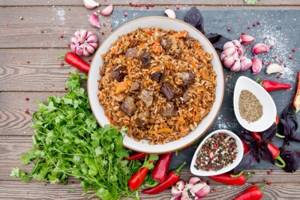
Correct khmeli-suneli always contains:
- marigolds (Imereti saffron);
- parsley (use whole branches with leaves);
- celery stalks;
- basil;
- cilantro (not seeds are used here, but leaves with stems);
- mint;
- marjoram;
- hyssop (a special type of shrub);
- dill;
- Bay leaf;
- savory;
- red hot pepper.
Dry leaves are taken in equal proportions and a little red pepper and saffron are added to them (only 0.1% of the total spices). The mixture is crushed and then added to dishes. As you can see, making suneli hops at home is not so easy. It is easier to buy a ready-made set from a trusted seller. But in fairness, it is worth noting that hops-suneli are rarely added to pilaf, but it goes perfectly with chakhokhbili and kharcho. It also makes amazing creamy nut sauces for hot poultry dishes.
Regardless of the purpose of spices, it is important to learn how to choose them wisely. To do this, pay attention to the quality of packaging, production time and choose natural ingredients without preservatives or flavor enhancers. Then any dish will turn out aromatic, unique and delicious! Enjoy your meal.
Recipe
You decide for yourself which meat is best to make pilaf from. In the meantime, let's look at the process of preparing real Uzbek pilaf. First you need to prepare the ingredients:
- Rice - 1 part.
- Carrots, onions - 1 part each.
- Meat - 1 part.
- Oil - 0.3 parts.
- Water - 1 part.
What does "one part" mean? You can choose the measure arbitrarily. But it is very convenient to take a 300 g faceted glass as such. Measure all the products immediately so that you do not have to return to this issue during the cooking process.
Rice should be soaked in cold water for 2 hours. After an hour, you need to rinse it, and then fill it with cold water again. This will wash away excess starch. Pour the cereal into a colander to drain. Excess liquid can ruin the entire dish, so you need to watch this especially carefully.
Now you need to prepare the refried. To do this, heat the frying pan very hot, pour in the oil and also heat it almost until smoking. After this, fry the meat cut into pieces, then chopped onion into rings and chopped carrots into strips. Focus on the readiness of vegetables. This is not so difficult; usually housewives understand well when carrots become soft.
You need to pour rice on top. There is no need to mix anything. Add water, you need exactly as much as rice. Be sure to use the handle of the spoon to poke five holes all the way to the bottom. Garlic cloves are placed in them. And now the most important thing. Close the cauldron with a very tight lid and reduce the heat to very low. The contents should gurgle a little. And don't open it even for a second. Set the timer for 70 minutes and go about your business.
After the time has passed, stir the pilaf, close and leave for another hour.
Closed lid
Why is this so important? Is it really impossible to look in and check if the dish is burning? If you do everything according to the recipe, then there is no need to worry. Nothing will burn. This is why a tight lid is needed. When the temperature reaches 75 degrees, starch begins to form on the pilaf grains, which becomes the cause of the paste-like consistency of the porridge. But when the temperature rises higher, to 96 degrees, the starch breaks down and turns into glucose, which is absorbed into the grains. When the lid is closed, steam rises to the top. This will cause the destruction of starch. As you can see, everything is very interconnected. Uzbeks cook pilaf in cauldrons over a fire. The temperature there is completely different, so nothing sticks together.
Pork
And we continue to consider which meat is better to cook pilaf from. Everything is clear with lamb, it’s a classic, but you don’t always have it on hand. Try making pork pilaf. The aroma of the dish turns out to be completely different, but this, again, is a matter of taste. Please note that this meat is a little sweet. This will have to be compensated with barberry and other spices.
What exactly should you choose from pork? What meat is best for pilaf? In this case, give preference to the back leg, shoulder or neck. But the loin is not suitable for stewing, as it will lose its juices during the cooking process and will turn out dry. The ribs will be very good. Do not forget that the layer of fat must be cut off from the meat, because excess fat will not be beneficial.
If the pork has been frozen, the defrosting process should take place at room temperature. Accelerating this process under running warm water or in the microwave degrades the quality of the meat, so it is better not to save time.
Beef
This is the favorite meat in almost every family. Fragrant, tasty, not too greasy, ideal in a stew. Beef is also suitable for pilaf. What kind of meat is better to take? For stewing, the preferred ones are shank, shoulder, brisket and shank. As with lamb, it is best to leave the hind leg out. The meat here is fibrous and tough. It is better to twist it into minced meat and add a little pork for tenderness.
Many people believe that only veal is used for cooking. In fact, properly prepared and aged beef is significantly superior in taste to veal. It needs to simmer for at least 3 hours, only after that it will be possible to cook pilaf on the resulting basis. Otherwise, the meat in the finished dish will be tough, and the aroma of the stew will not have time to develop.
Seasoning for pilaf with barberry
Traditional composition
Dried barberry goes well with lamb, the only true meat for pilaf, according to Uzbeks, which is why mixtures based on this berry are very popular. This does not mean that other types of meat do not combine well with it: barberry is added to pork, beef, turkey, duck and chicken; can be used either alone or mixed with other spices.
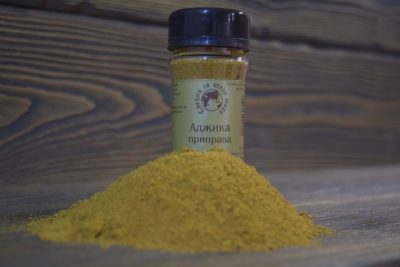
You can also make the seasoning yourself - to do this, grind the dried fruits through a meat grinder, crush them in a mortar or grind them in a coffee grinder. The rest of the spices, especially cumin, can be subjected to the same procedure so that it gives more flavor.
Perfect pilaf recipe
Of course, every housewife has her own. Some people cook the dish in a saucepan, others believe, and not without reason, that the best pilaf is in a cauldron. We have already discussed what meat to use for this. There is no definite answer to this question and there cannot be. But judging by the numerous reviews, this recipe always turns out successful and pleases the guests. Therefore, we write down another cooking option and try it in the very near future. You will need:
- Beef meat - 900 g.
- Long grain rice - 2.5 cups.
- 3-4 onions and the same amount of carrots.
- Olive oil - half a glass.
- Hot pepper - one pod each green and red.
- Seasonings - 1 tsp. cumin and turmeric.
It is best to take the shoulder blade with white fat and not too dark meat. Let's prepare all the ingredients. This is the most time consuming part.
- Carrots need to be cut into thin strips.
- Chop the onion into cubes.
- Be sure to dry the beef with a paper towel and cut into cubes.
- Heat the oil in a cauldron and fry the meat until golden brown.
- Add the onion and wait for it to fry.
- It's the carrot's turn. Simmer it until done. Add barberries and whole peppers during the process.
When the vegetables are ready, pour water over the meat and remove the peppers. Now you need to simmer the contents of the cauldron (pan) until the meat is soft and the water evaporates. Regulate the amount of liquid. If the meat is already ready and there is still water, then you need to increase the heat and evaporate it. Now pour out the rice, add water in a 1:2 ratio and close the lid, leaving a small hole. After 40 minutes, you will need to remove the lid and add the garlic. If by this time the water has evaporated, then you can turn off the heat and stir the pilaf. After this, it needs to be wrapped and left to evaporate for 20-30 minutes. Soon you will be able to enjoy the most delicious pilaf.
Slicing carrots for pilaf - 3 ways
Traditionally, for pilaf, carrots taken from the autumn harvest are medium-sized, cylindrical in shape and cut into coarse strips or cubes approximately 4–5 millimeters thick.
They do this manually, because combines and other devices ruffle the edges, which is why the vegetable loses its shape under the influence of temperature and becomes brittle.
There are three ways to properly cut carrots:
- Peeled carrots are cut into cylinders (“hemps”) no less than 4 centimeters high. Now they need to be cut into plates. To do this, you can either hold them vertically, or thinly cut off one rounded side and lay the “stump” with the resulting flat part down. The plates are stacked in 2-5 pieces - depending on the chef's skill - and cut into strips along the long edge.
- The carrots are cut into cylinders and plates similarly to the first point, then cut diagonally. This method is preferable for long straws; they will be more flexible and will not break during heat treatment.
- The roundness of a whole carrot is carefully cut off on one side so that it can be placed firmly on the board. Then cut diagonally into ovals of at least 4 cm in length. The ovals are stacked and chopped into strips.
It is believed that the longer the straw, the tastier the pilaf.
Poultry meat
When talking about what kind of meat is best for pilaf, we must not forget about chicken. But forget about factory chickens. You need a domestic chicken, big and fat. Depending on the size of the cauldron, you can cut off half the carcass. Here we will not highlight the wings, legs and breast. Half the carcass should be cut into equal pieces and fried in a cauldron. After the pieces acquire a golden color, they are removed from the cauldron and the carrots and onions are fried. Then put back the meat and rice. This is necessary so that the tender meat does not fall apart into fibers during the stewing process.
Alternative options
What kind of meat do you want to use for pilaf? Do you have a piece of horse meat at home? Great. It will make a very tasty pilaf. The only rule: it cannot be fried, otherwise the meat will become inedible. Simmer it well, then add it to the fried onions and carrots. At this point, the frying can be considered ready.
A tender rabbit can also become the basis for pilaf. But the sweetish meat cooks very quickly and does not require frying at all. Therefore, first we cook the vegetables, then lay out the rabbit and almost immediately add rice. Even with the spices, the taste is very delicate. Not everyone likes this option, but rabbit meat is considered dietary meat, unlike pork or lamb.
